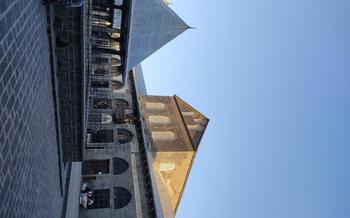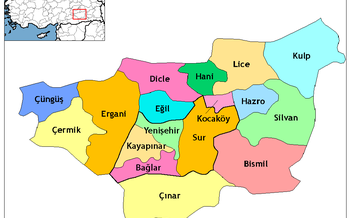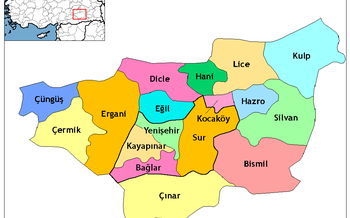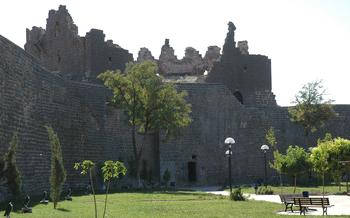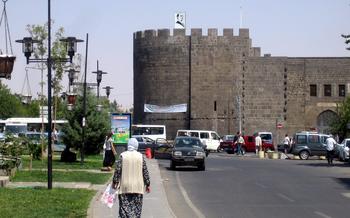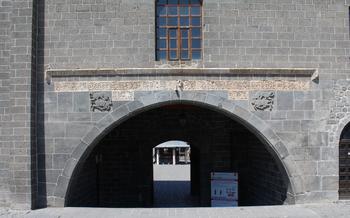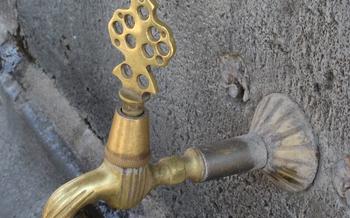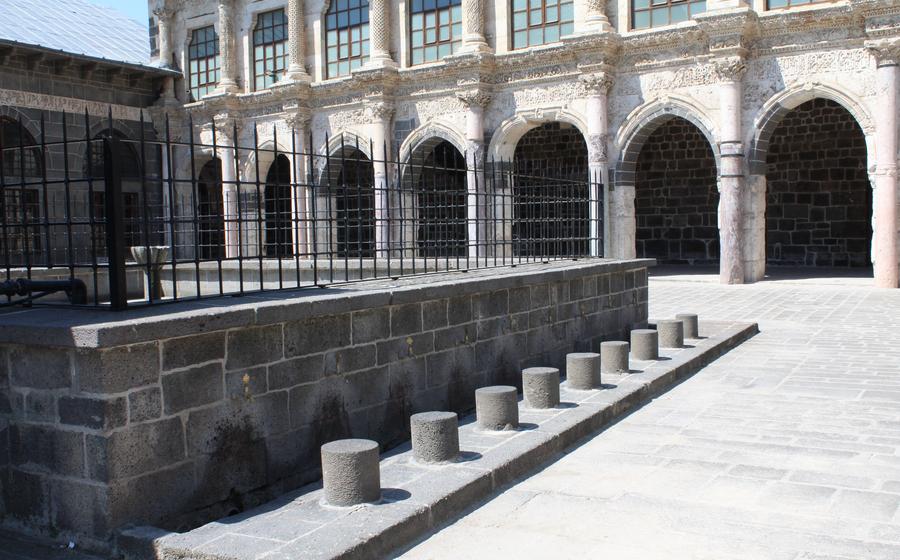
Saraykapı
- The Antiquity of Saraykapı
- The Fortifications of Saraykapı
- The Great Mosque of Diyarbakır: A Majestic Symbol of Faith and History
- The İçkale
- The Mardin Kapı
- The Ziya Gökalp Museum
- The Sülüklü Han
- The Hasırlı Han: A Testament to Economic and Cultural Exchange
- The Ali Paşa Hamamı
- The Diyarbakır Fortress
- The Museum of Diyarbakır: A Treasure Trove of Cultural Heritage
- The Cahit Sıtkı Tarancı Park
- A verdant sanctuary
- Recreational haven
- A place for relaxation
- A place for recreation
- A place for cultural events
- Insider tip
- Diyarbakır Cuisine: A Culinary Journey Through History and Culture
- Insider Tip: Unveiling Hidden Gems
The Antiquity of Saraykapı
In Diyarbakır, Turkey, lies a captivating site known as Saraykapı, steeped in ancient history and cultural significance. Its origins can be traced back to prehistoric times, with evidence suggesting human habitation dating back to the 4th millennium BC. This remarkable site has witnessed the rise and fall of civilizations, leaving behind a treasure trove of artifacts and architectural wonders that captivate visitors to this day.
A visit to the on-site museum provides a glimpse into the rich history of Saraykapı. The exhibits showcase unearthed relics, offering a tangible connection to the past. During my visit, I had the privilege of meeting an archaeologist who shared fascinating insights about the site's prehistoric origins. He explained how recent excavations have uncovered evidence of early settlements, including stone tools, pottery fragments, and remnants of ancient dwellings.
As I listened to the archaeologist's passionate explanations, I couldn't help but feel a sense of awe and wonder. Saraykapı stood as a testament to the enduring legacy of human civilization, a place where history whispered secrets from a bygone era.
The Fortifications of Saraykapı
The imposing city walls and gates of Saraykapı stand as a testament to the city's rich history and strategic significance. These fortifications, constructed over centuries, served as a formidable defense against invaders, ensuring Diyarbakır's resilience and prosperity.
The walls, stretching for several kilometers, are a marvel of ancient engineering. Constructed using massive stone blocks, they feature numerous towers and bastions that provided archers and soldiers with vantage points to repel attacks. The gates, equally impressive, are adorned with intricate carvings and inscriptions, hinting at the city's cultural heritage.
From a theoretical perspective, these fortifications played a crucial role in Diyarbakır's military strategy. The city's location on the Silk Road made it a target for various empires and armies. The sturdy walls and gates acted as a deterrent and provided a safe haven for the city's inhabitants during times of conflict.
For a practical experience, visitors can walk along the ramparts of the city walls. This offers panoramic views of Diyarbakır, showcasing its sprawling cityscape and the surrounding countryside. The walk is a unique opportunity to appreciate the scale and grandeur of these ancient fortifications.
During my visit, I had the chance to witness a reenactment of ancient defense drills by local enthusiasts. Dressed in traditional attire, they demonstrated how soldiers would have manned the walls and repelled invaders using bows and arrows, providing a glimpse into the city's rich military history.
The Great Mosque of Diyarbakır: A Majestic Symbol of Faith and History
The Great Mosque of Diyarbakır, also known as the Ulu Cami, stands as a testament to the city's rich Islamic heritage. Constructed in the 11th century during the reign of the Artuqid dynasty, this architectural masterpiece is renowned for its grandeur and intricate craftsmanship.
Description and Architectural Features:
The Great Mosque's imposing structure boasts a spacious courtyard, a prayer hall with multiple domes, and a towering minaret. The facade is adorned with elaborate carvings, geometric patterns, and Quranic inscriptions, showcasing the exceptional artistry of the period. The interior is equally impressive, with rows of elegant columns supporting the vaulted ceilings. The mihrab, the niche indicating the direction of prayer, features intricate tilework and calligraphy, adding to the mosque's spiritual ambiance.
Historical Importance:
The Great Mosque has played a pivotal role in Diyarbakır's religious and cultural life for centuries. It served not only as a place of worship but also as a center for education and community gatherings. The mosque's strategic location within the city walls further highlights its significance as a symbol of Islamic authority and power.
Practical Suggestion:
To fully appreciate the mosque's grandeur, consider attending a prayer or participating in a guided tour. These tours provide insights into the mosque's history, architectural features, and religious significance. Don't forget to dress modestly and respectfully, as the mosque is an active place of worship.
Anecdote:
During my visit to the Great Mosque, I had the opportunity to engage in a fascinating conversation with a local resident. He shared insights into the mosque's religious traditions, explaining the significance of the five daily prayers and the importance of community gatherings during religious festivals. His passion for his faith and the mosque's role in his life left a lasting impression on me.
The İçkale
The İçkale is a captivating inner citadel that once served as the administrative and military hub of Diyarbakır. It stands as a testament to the city's rich history and strategic importance. Within its walls, one can find remnants of ancient civilizations that once called this land home.
Historical Notion
As you explore the İçkale, you'll uncover the fascinating layers of history that have shaped its existence. From the prehistoric origins of the site to its role as the center of the ancient Hurrian kingdom, the İçkale has witnessed countless battles, conquests, and cultural exchanges.
Practical Suggestion
To fully immerse yourself in the charm of the İçkale, we recommend venturing into its narrow, winding streets. Get lost in the maze-like alleys and uncover hidden gems like quaint cafes, artisan workshops, and serene courtyards. Don't be afraid to interact with the friendly locals, who are always eager to share stories and insights about their beloved city.
Anecdote
During my visit to the İçkale, I stumbled upon a hidden courtyard tucked away from the bustling streets. As I wandered through its secluded corners, I discovered a group of local children playing traditional games. It was a heartwarming moment that reminded me of the enduring spirit of this ancient city.
The Mardin Kapı
The Mardin Kapı, also known as the Urfa Kapı, stands as a monumental gateway to the ancient city of Diyarbakır. This imposing structure, dating back to the 4th century AD, is a testament to the city's rich history and architectural prowess. Its massive stone archway, adorned with intricate carvings and inscriptions, reflects the artistic and cultural influences that have shaped Diyarbakır over the centuries.
As the main entrance to the city, the Mardin Kapı held great symbolic importance. It served as a welcoming portal for visitors and traders, while also demonstrating the city's strength and resilience. The gate's strategic location allowed for effective control over who entered and exited the city, contributing to its security and defense.
To truly appreciate the grandeur of the Mardin Kapı, take a moment to photograph its impressive facade. Capture the intricate details of the carvings, the weathered stonework, and the sheer scale of the structure. Each element tells a story of the city's past, adding depth and meaning to your visit.
While admiring the Mardin Kapı, engage in conversation with the locals who often gather nearby. They may share fascinating legends and stories associated with the gate, passed down through generations. Listen to their tales of ancient battles, heroic figures, and the significance of this iconic landmark in the hearts of Diyarbakır's people.
The Ziya Gökalp Museum
In Diyarbakır, amidst a sanctuary dedicated to the life and works of the renowned Turkish scholar, poet, and sociologist, Ziya Gökalp. As you step through its doors, you embark on a journey into the mind of a man who left an indelible mark on Turkish nationalism and literature.
Ziya Gökalp was born in Diyarbakır in 1876 and rose to prominence as a leading figure in the early 20th century's intellectual and political landscape. His writings on Turkish identity, social reform, and cultural heritage continue to resonate deeply within Turkish society.
The museum, housed in a beautifully restored historical building, showcases Gökalp's personal belongings, manuscripts, and publications. Through interactive exhibits, visitors can delve into his life story, his contributions to Turkish thought, and the lasting impact of his ideas.
Practical Suggestion:
Before visiting the museum, take some time to familiarize yourself with Gökalp's works. Reading his essays, poems, and sociological treatises will provide a deeper context for understanding the exhibits and his significance in Turkish history.
Anecdote:
During my visit to the Ziya Gökalp Museum, I had the privilege of meeting a passionate guide who shared personal anecdotes about Gökalp's life and legacy. He spoke of Gökalp's dedication to education, his love for his hometown, and his unwavering belief in the potential of the Turkish nation. It was a truly enriching experience that brought Gökalp's contributions to life.
The Sülüklü Han
Amidst the labyrinthine streets of Saraykapı, stands the Sülüklü Han, a magnificent caravanserai that has borne witness to centuries of history. Built in the 15th century, this architectural marvel served as a sanctuary for weary travelers and traders traversing the Silk Road. Its name, meaning "leech," is a testament to the medicinal properties of the leeches that were once bred in the han's courtyard.
Stepping through the grand entrance, visitors are greeted by a vast courtyard surrounded by two-story galleries. The intricate carvings adorning the arches and columns showcase the exceptional craftsmanship of the era. The ground floor features stables where caravans of horses and camels would seek respite, while the upper level provided comfortable lodgings for merchants and their goods.
Beyond its practical function, the Sülüklü Han also served as a vibrant hub of cultural exchange. Merchants from distant lands gathered here, sharing stories, ideas, and goods from across the globe. The caravanserai's strategic location facilitated trade and commerce, contributing to the economic prosperity of Diyarbakır.
Today, the Sülüklü Han has been lovingly restored and transformed into a vibrant cultural center. Visitors can wander through the beautifully preserved courtyard, admiring the architectural details and imagining the bustling atmosphere of bygone eras. The surrounding shops offer a treasure trove of local handicrafts and souvenirs, allowing visitors to take a piece of Saraykapı's rich heritage home with them.
In the heart of the caravanserai, a small museum narrates the fascinating history of the Sülüklü Han and its role in the region's trade and cultural development. Through captivating exhibits and interactive displays, visitors gain a deeper understanding of the caravanserai's significance and its enduring legacy.
As you explore the Sülüklü Han, be sure to engage with the friendly locals who are eager to share stories and anecdotes about this iconic landmark. Their personal connections and insights will enrich your visit, providing a glimpse into the soul of Saraykapı and its people.
The Hasırlı Han: A Testament to Economic and Cultural Exchange
The Hasırlı Han, an architectural marvel dating back to the 16th century, stands as a testament to Diyarbakır's rich history as a crossroads of cultures and a hub of economic activity. Its imposing structure, adorned with intricate carvings and elegant arches, reflects the city's status as a prominent trading center along the Silk Road.
In its heyday, the Hasırlı Han served as a caravanserai, providing weary travelers and merchants with a safe haven and a place to rest and replenish their supplies. Its spacious courtyard, surrounded by two-story galleries lined with rooms, accommodated caravans of camels and horses, while the merchants could conduct their business in the bustling bazaar within the complex.
Beyond its practical function, the Hasırlı Han also played a crucial role in fostering cultural exchange. Merchants from far-off lands brought with them not only their goods but also their ideas, customs, and traditions, contributing to the vibrant cultural tapestry of Diyarbakır. The caravanserai served as a meeting ground where people from diverse backgrounds could interact, share stories, and learn from one another.
In keeping with its historical significance, the Hasırlı Han has been meticulously restored and transformed into a vibrant cultural center. Today, visitors can wander through its beautifully preserved courtyards, admire the intricate craftsmanship of its architecture, and experience the lively atmosphere of the shops and restaurants that line its galleries.
Practical Suggestion:
Take the opportunity to savor the flavors of Diyarbakır's renowned cuisine at one of the traditional restaurants within the Hasırlı Han. Indulge in delectable dishes such as "kaburga dolması" (stuffed lamb ribs), "mırra" (a unique type of coffee), and the city's signature sweet treat, "şırdan."
Anecdote:
During my visit to the Hasırlı Han, I had the privilege of meeting a local artisan who shared with me his passion for preserving traditional crafts. He demonstrated the intricate art of copper engraving, a skill that has been passed down through generations in his family. It was a fascinating glimpse into the living heritage of Diyarbakır and the artisans who keep its traditions alive.
The Ali Paşa Hamamı
Amidst the bustling streets of Diyarbakır, stands the Ali Paşa Hamamı, a testament to the city's rich history and cultural heritage. This magnificent bathhouse, built in the 16th century, invites visitors to step back in time and experience the traditional Turkish bathing rituals that have been cherished for centuries.
Theoretical Notion:
Bathhouses, known as hamams, hold a significant place in Turkish culture, serving as social hubs where people from all walks of life come together to cleanse, relax, and socialize. These communal spaces have played a vital role in promoting health, hygiene, and community bonding.
Practical Suggestion:
To fully immerse yourself in the authentic Turkish bathing experience, it is highly recommended to indulge in a traditional hammam ritual. Begin by undressing in the changing room, known as the soyunmalık, and wrapping yourself in a peştemal, a traditional Turkish towel.
Anecdote:
During my visit to the Ali Paşa Hamamı, I had the privilege of meeting an elderly gentleman who shared fascinating stories about the history of the bathhouse. He spoke of a time when it was a bustling center of activity, with locals and travelers alike seeking respite and rejuvenation within its walls.
The Diyarbakır Fortress
In the heart of Diyarbakır, standing as a testament to the city's resilience, lies the magnificent Diyarbakır Fortress. This colossal structure, with its imposing walls and strategic location, has played a pivotal role in defending the city against countless invasions and sieges throughout history.
The fortress, built upon a rocky hill overlooking the city, offers breathtaking panoramic views that extend far beyond the city limits. From its vantage point, one can appreciate the vastness of the surrounding landscape and the strategic importance of Diyarbakır as a crossroads of civilizations.
Exploring the fortress is a journey through time, where each stone whispers tales of battles fought and victories won. The massive walls, adorned with intricate carvings and inscriptions, stand as silent witnesses to the city's rich history and cultural heritage.
As you walk through the fortress grounds, you'll encounter remnants of its military past, including barracks, stables, and underground tunnels that once served as secret passages and escape routes. The fortress's strategic design, with its multiple layers of defense and fortified gates, is a testament to the ingenuity and resilience of the city's ancient builders.
A visit to the Diyarbakır Fortress is not just a historical exploration but also an opportunity to connect with the spirit of the city. As you climb to the top of the fortress and gaze out over the city below, you'll feel a sense of awe and wonder at the rich history and cultural heritage that Diyarbakır embodies.
The Museum of Diyarbakır: A Treasure Trove of Cultural Heritage
The Museum of Diyarbakır stands as a testament to the city's rich and diverse past. Housed in a beautifully restored historical building, the museum showcases a vast collection of artifacts and exhibits that narrate the story of Diyarbakır's cultural heritage. From ancient pottery and sculptures to intricate textiles and manuscripts, the museum offers a glimpse into the region's vibrant history and artistic traditions.
Theoretical Notion: Preserving and Showcasing Cultural Heritage
Museums play a crucial role in preserving and showcasing cultural heritage, ensuring that the past remains alive for future generations. The Museum of Diyarbakır is a prime example of this, as it houses a collection that spans thousands of years and represents the diverse cultures that have shaped the city. By preserving these artifacts and exhibits, the museum contributes to the preservation of Diyarbakır's unique identity and heritage.
Practical Suggestion: Guided Tour for Deeper Insights
To fully appreciate the significance of the museum's collection, consider taking a guided tour. Knowledgeable guides will provide insights into the history and cultural context of the artifacts, helping you understand their importance and significance. Guided tours are available in various languages, making the museum accessible to visitors from around the world.
Anecdote: A Rare Discovery Unveiled
During my visit to the museum, I had the privilege of seeing a rare artifact that had recently been discovered during an excavation. It was a beautifully preserved ancient seal, intricately carved with symbols and inscriptions that hinted at the rich history of the region. The museum curator explained that the seal was still being studied, but it was believed to date back to the Bronze Age. It was a thrilling experience to see such a unique and significant artifact up close and to learn about its potential historical significance.
The Museum of Diyarbakır is a must-visit destination for anyone interested in exploring the cultural heritage of this ancient city. Its collection is diverse, informative, and beautifully displayed, offering a glimpse into the rich past of Diyarbakır and the surrounding region.
The Cahit Sıtkı Tarancı Park
Amidst the bustling city of Diyarbakır, the Cahit Sıtkı Tarancı Park stands as a tranquil oasis, inviting visitors to escape the urban clamor and immerse themselves in its serene ambiance. Named after the renowned Turkish poet Cahit Sıtkı Tarancı, this park is a testament to the city's appreciation for both nature and the arts.
A verdant sanctuary
As you step into the park, you are greeted by meticulously landscaped gardens, adorned with vibrant flowers, lush greenery, and towering trees. The air is filled with the sweet fragrance of blooming roses and the cheerful chirping of birds, creating a symphony of nature that soothes the soul.
Recreational haven
Beyond its aesthetic beauty, the Cahit Sıtkı Tarancı Park offers a myriad of recreational opportunities for visitors of all ages. Whether you seek active pursuits or moments of relaxation, this park has something to cater to your needs.
A place for relaxation
For those seeking tranquility, the park provides ample space to unwind and reconnect with nature. Take a leisurely stroll along the winding paths, find a secluded spot beneath a shady tree to immerse yourself in a good book, or simply bask in the warm sunshine while enjoying the serene atmosphere.
A place for recreation
If you are feeling more energetic, the park offers a range of recreational facilities to keep you engaged. Children can frolic in the well-equipped playground, while adults can challenge themselves on the basketball court or football field. There are also designated areas for picnics, where you can spread out a blanket, savor delicious homemade treats, and share laughter with loved ones.
A place for cultural events
The Cahit Sıtkı Tarancı Park is not just a place for recreation but also a vibrant cultural hub. Throughout the year, the park hosts a variety of events that celebrate art, music, and local traditions. From poetry readings and art exhibitions to traditional dance performances and concerts, there is always something new and exciting to experience.
Insider tip
For a truly unique experience, visit the park during the annual Diyarbakır Watermelon Festival, held every August. Immerse yourself in the joyous atmosphere as locals and visitors alike come together to celebrate the city's famous watermelon harvest. Enjoy live music, traditional games, and, of course, plenty of delicious watermelon treats.
Diyarbakır Cuisine: A Culinary Journey Through History and Culture
The city of Diyarbakır is renowned for its rich and flavorful cuisine, a testament to the diverse cultural influences that have shaped the region over centuries. From hearty meat dishes to delicate pastries, the culinary landscape of Diyarbakır offers a tantalizing journey for food enthusiasts.
One must-try dish is "kaburga dolması," a delectable delicacy consisting of tender lamb ribs stuffed with a fragrant mixture of rice, spices, and aromatic herbs. Cooked to perfection, the ribs fall off the bone, releasing a symphony of flavors that dance on the palate.
Another local specialty is "mırra," a unique type of coffee that holds a special place in the hearts of Diyarbakır residents. Prepared using a traditional method, mırra is brewed in small pots and served in tiny cups, offering a robust and intense flavor that awakens the senses.
Diyarbakır's culinary scene is not limited to savory dishes. The city is also famous for its sweet treats, such as "hasude," a delightful dessert made from shredded phyllo dough, nuts, and syrup. The delicate layers of pastry, combined with the sweetness of the syrup and the crunch of the nuts, create a harmonious balance of flavors that will satisfy any sweet tooth.
To fully immerse oneself in the culinary delights of Diyarbakır, one should venture beyond the main tourist areas and explore the traditional Kurdish markets. These vibrant marketplaces offer an array of authentic souvenirs and local delicacies, including freshly baked breads, homemade pickles, and aromatic spices.
During my visit to Diyarbakır, I had the privilege of cooking a traditional dish with a local chef. Together, we prepared a hearty "tirid," a stew made with lamb, vegetables, and a rich tomato-based sauce. The chef shared stories about the history and cultural significance of the dish, making the experience not only delicious but also educational.
Whether it's savoring the succulent flavors of "kaburga dolması," sipping on a cup of strong "mırra," or exploring the hidden culinary gems of the traditional markets, Diyarbakır's cuisine is an integral part of the city's rich cultural tapestry, inviting visitors to embark on a culinary adventure that will linger in their memories long after they leave.
Insider Tip: Unveiling Hidden Gems
Beyond the prominent landmarks, Saraykapı holds hidden gems waiting to be discovered. Venture off the beaten path and explore the traditional Kurdish markets, a treasure trove of authentic souvenirs and local delicacies. Immerse yourself in the vibrant atmosphere as you barter with friendly vendors and uncover unique handcrafted items.
In one of my explorations, I stumbled upon a hidden courtyard adorned with stunning murals and artwork. It was as if I had stepped into a secret garden, a sanctuary of creativity and expression. The vibrant colors and intricate designs captivated my senses, leaving me in awe of the talent and artistry of the local community.
These hidden gems offer a glimpse into the heart and soul of Saraykapı, revealing its rich cultural heritage and the creativity of its people. Embrace the opportunity to explore beyond the main tourist attractions and discover the hidden treasures that await those willing to venture off the beaten path.

